Long erased from classical narratives, Africa was nonetheless a key player in Greco-Roman Antiquity: Ethiopian kings, Nubian queens, Egyptian thinkers, Black soldiers, Roman citizens. This grand narrative—woven between organized silences and recovered memory—reveals a plural Antiquity.
What if, behind the white marble of Rome, lay a history woven from shadow, gold, and ebony?
The black faces of antiquity
Africa at the Origins of the Classical World

In the Western imagination, the cradle of Western civilization is twofold: Athens for thought, Rome for power. This vision, polished by centuries of colonial and Eurocentric narrative, often relegates Africa to the margins of History. Yet, on closer inspection, Africa was not only present, but central to the worldview and formation of the Greco-Roman universe.
There is a truth that Western academic history long suppressed or distorted: Classical Greece was nourished at the table of Africa.
To the ancient Greeks, Egypt was not some exotic mystery or a land to be conquered. It was a sanctuary of knowledge, an ancient place where wisdom seemed embedded in stone, temples, and rivers. Long before Europe claimed a monopoly on reason, the banks of the Nile were seen as an ancient school of philosophy, science, and spirituality.
Herodotus, in his Histories, leaves little doubt: to him, the Egyptians invented writing, mathematics, medical principles, and passed on a share of this intellectual treasure to the Greeks.
“Clearly the Colchians are of Egyptian race; but the Egyptians told me they believed the Colchians to be descended from the soldiers of Sesostris. I had conjectured this myself from two indicators: first, because they have black skin and woolly hair; and second, and more decisively, because, among all men, only the Colchians, Egyptians, and Ethiopians have practiced circumcision from the beginning.
The Phoenicians and the Syrians of Palestine admit that they learned this custom from the Egyptians. The Syrians who live near the rivers Hermus and Pathenios, and the Macrones who are their neighbors, say they recently adopted it from the Colchians.
These are the only peoples who practice circumcision, and it is observable that they do it in the same way as the Egyptians.
As for the Egyptians and Ethiopians themselves, I cannot say which learned the practice from the other, for it is clearly very ancient among them; but that it was learned through contact with Egypt is for me a strong proof: all Phoenicians who have dealings with Greece stop imitating the Egyptians in this respect and do not circumcise their descendants.”
— Herodotus, Histories, Book II, Chapter 104
This judgment is not isolated. Numerous ancient authors (Strabo, Diodorus of Sicily, Plutarch) repeat—sometimes in admiration, sometimes in puzzlement—that the Greeks drew from Egyptian sources.
“The Ethiopians say that the Egyptians are one of their colonies, brought into Egypt by Osiris. They even claim that the land itself was originally sea, filled in over time by Nile floods carrying silt from Ethiopia.
They add that the Egyptians owe them most of their laws, their practice of venerating kings as gods, and their elaborate funeral rites. Sculpture and writing, too, were born in Ethiopia.”
— Diodorus of Sicily, Book III
Legendary figures such as Homer, Orpheus, Solon, and Thales of Miletus are described as having traveled to Egypt. Even Pythagoras—whose theorem is taught in every Western school—was said to have been initiated in the temples of Memphis or Heliopolis, among African priests. There, he would have learned not only mathematics, but also cosmology, reincarnation, and the harmony of the spheres—core ideas of his teaching.
“This is attested unanimously by the wisest of the Greeks: Solon, Thales, Plato, Eudoxus, Pythagoras, and according to some, even Lycurgus, all traveled to Egypt and conversed with its priests.
Eudoxus is said to have been taught by Conuphis of Memphis, Solon by Sonchis of Sais, and Pythagoras by Enuphis the Heliopolitan.
Pythagoras in particular, filled with admiration for these priests, inspired by their example, imitated their enigmatic and mysterious language, wrapping his doctrines in allegory. Most of these precepts are no different from what Egyptians call hieroglyphs.”
— Plutarch
These are not merely embellished myths. Today, archaeological and philological consensus confirms the existence of very concrete knowledge flows between the Nile Valley and the Aegean Sea, notably through major Egyptian delta cities such as Naucratis, where Greeks and Egyptians coexisted as early as the 7th century BCE.
“It is striking that almost no Egyptian scholars’ names have survived. By contrast, nearly all their Greek disciples went down in history, claiming the inventions and discoveries of their anonymous Egyptian masters as their own.
This is evident in the passages from Iamblichus and the writings of Herodotus, who refers to Pythagoras presenting himself as the originator of ideas taught by his Egyptian instructors.”
— Cheikh Anta Diop, The African Origin of Civilization
Africa, in its Egyptian form, was therefore not outside the Classical Age. It was foundational. It represented an intellectual matrix that even the Greeks did not deny. But as modern Europe established itself as the center of rationality, this past was downgraded, repressed, sometimes uprooted in favor of a narrative of Hellenic purity.
It took rediscovering these connections. It required rereading Herodotus, excavating Saqqara, comparing ancient treatises. It took voices like that of Cheikh Anta Diop to remind us that Africa was not a shadow, but a light—the one that was hidden.
“The contemporaries of the birth of modern Egyptology knew perfectly well that Egypt was a Black and Negro-African civilization, but they knowingly falsified history.”
— Cheikh Anta Diop, French Television, RFO, 1983
Thus, before becoming a footnote in textbooks, Africa was a model for the masters of philosophy. A school of the world that history tried to forget—but that memory refuses to Long before Africa was painted by Europeans as a land of darkness, savagery, or backwardness, it was—for the ancient Greeks—a moral compass, almost a philosophical ideal.
In classical literature, the Ethiopians occupy a surprising place. The Greek word Aithiopes, literally “burnt face,” referred to the peoples south of Egypt—beyond the known world, but not beyond respect. Quite the contrary. In Homer, they are spoken of with admiration. In the Iliad, the gods of Olympus leave their heavenly thrones to feast with them. That single scene holds immense symbolic power: there is no divine hierarchy that relegates them—there is communion, a sacred banquet where people eat, speak, and laugh… with Black people.
Homer writes that the Ethiopians are “the most just of men.” That is a moral judgment, not a biological classification. In the archaic Greek imagination, Ethiopia is not a land of fear or conquest. It is a land of balance, where people live according to laws respected even by the gods.
This is far removed from later visions, in which Black peoples would be associated with bestiality, irrationality, or absolute otherness. Here, in the dawn of Western thought, Africa is a model of virtue—a source not only geographical, but spiritual.
This perspective is ancient, nuanced, complex. For the Greeks, otherness operated on multiple levels: customs, traditions, language, behavior. Skin color, though observed, was not yet the foundation of a systemic hierarchy. It was a characteristic among others—not a marker of worth.
That does not mean it was an “egalitarian” view in the modern sense. We must not project our contemporary ideals onto Antiquity. But we must recognize that racism based on biology (the kind that triumphed with the transatlantic slave trade and colonization) had not yet emerged. Prejudices existed, of course—but Black skin was not, in itself, synonymous with inferiority.
And this is what makes that era a vital crossroads to rediscover. Because if the Greeks were capable of imagining a plural humanity without sorting it into fixed races, it means other relationships to the world were possible. Other cosmologies. Other futures.
It is our responsibility today to reactivate that memory—not to mythologize the past, but to dismantle the modern myths that have covered history in silence and whitewashing.
From mythical Ethiopia to historical Kemet, Africa is not on the margins of Greco-Roman history. It is its backdrop, its original material, and at times, its sacred horizon.
Memnon, the black hero of the trojan war
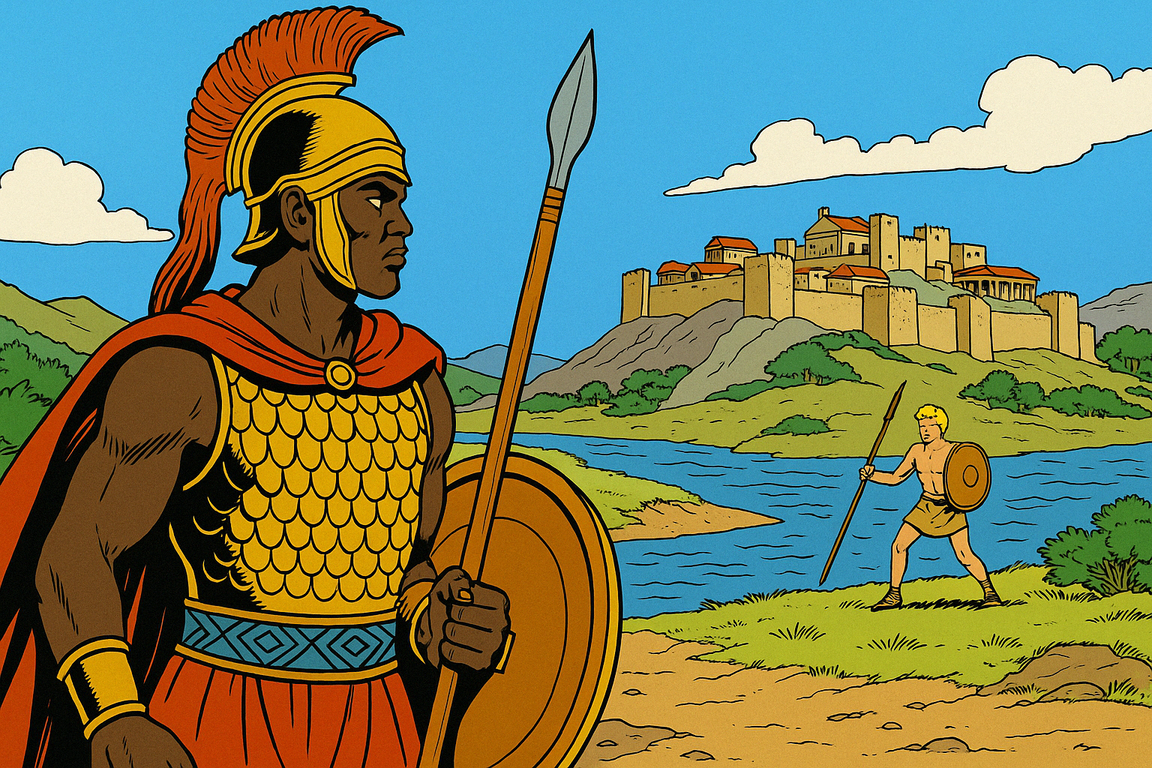
In the pantheon of European memory, there is a missing figure whose silhouette reappears, shadowed in gold and oblivion: Memnon, king of Ethiopia, son of the Dawn and Tithonus. A Black hero, celebrated by the Ancients, erased by the Moderns.
Memnon is not strictly a character from the Iliad. He appears in the so-called “cyclic epics,” later works often relegated to the margins of the Homeric canon. But his importance is by no means secondary: he is the one who dares to confront Achilles—and almost defeats him. He kills Antilochus, faces the demigod, and in a clash of near-cosmic intensity, he falls. But not as a vanquished man. He dies in splendor. And Zeus grants him immortality—an honor rare and reserved for the chosen few.
This apotheosis is not a trivial detail. In a culture where immortality is the mark of the divine or the just, Zeus’s gesture consecrates Memnon not only as a tragic hero but as Achilles’s equal.
And yet, it is only in Hellenistic literature—several centuries after the composition of the Homeric texts—that his skin color becomes a central attribute. Agatharchides of Cnidus, Theodorus of Sicily, and other later authors specify: Memnon was a king of Ethiopia, a Black man, a son of the African continent. His kingdom was thought to lie beyond Upper Egypt, in what the Greeks called Aithiopia—an expansive southern realm still undefined in ancient geography.
Memnon, then, is Black. And he is neither slave, nor servant, nor exotic curiosity. He is a king, a warrior, a hero—almost a demigod. In a tradition that prizes bravery, honor, and divine ancestry, his place is indisputable.
What this case reveals is a shift in memory. As Europe drifted from its Mediterranean roots and began constructing its colonial empires, it rewrote its past. Black heroes became inconvenient. African references were reclassified as marginal. Memnon, once celebrated, was forgotten.
His name vanished from schoolbook versions of the Trojan tales. Modern adaptations—whether literary, cinematic, or educational—leave him out. Why? Because the worldview changed. Because the 19th century needed a world that was hierarchized, racialized—a world in which Antiquity was white and Africa silent.
Where Homer and his heirs saw a royal African warrior, figures like Gobineau, Renan, or Vacher de Lapouge (theorists of white racial superiority) could not tolerate the idea of a Black hero within Europe’s cultural matrix.
The return of Memnon in contemporary research is not an academic footnote. It is an act of intellectual restoration. It affirms that the Greek imagination was far broader than the modern West wanted to believe. It shows that ancient representations allowed for powerful, admirable, complex Black figures.
Historian Frank M. Snowden, in his work on Black people in Antiquity, always emphasized: racism, as we know it, was not foundational to the Greco-Roman world. There were prejudices, mockery, hierarchies—but no racial inferiority doctrine rooted in biology.
Thus, Memnon’s presence did not shock the Ancients. It only became problematic with the rise of modern racism.
Memnon is therefore a key figure of memory. He represents what could have been: a plural Antiquity, a Europe aware of its African roots, an imaginary without exclusion.
The very fact that we must now restore his figure is telling: forgetting is never neutral. It is construction. It is power.
To rehabilitate Memnon is to fracture the myth of a white Antiquity—and to remember that at Troy, already, heroes could be Black, African, and glorious.
Africans in Rome
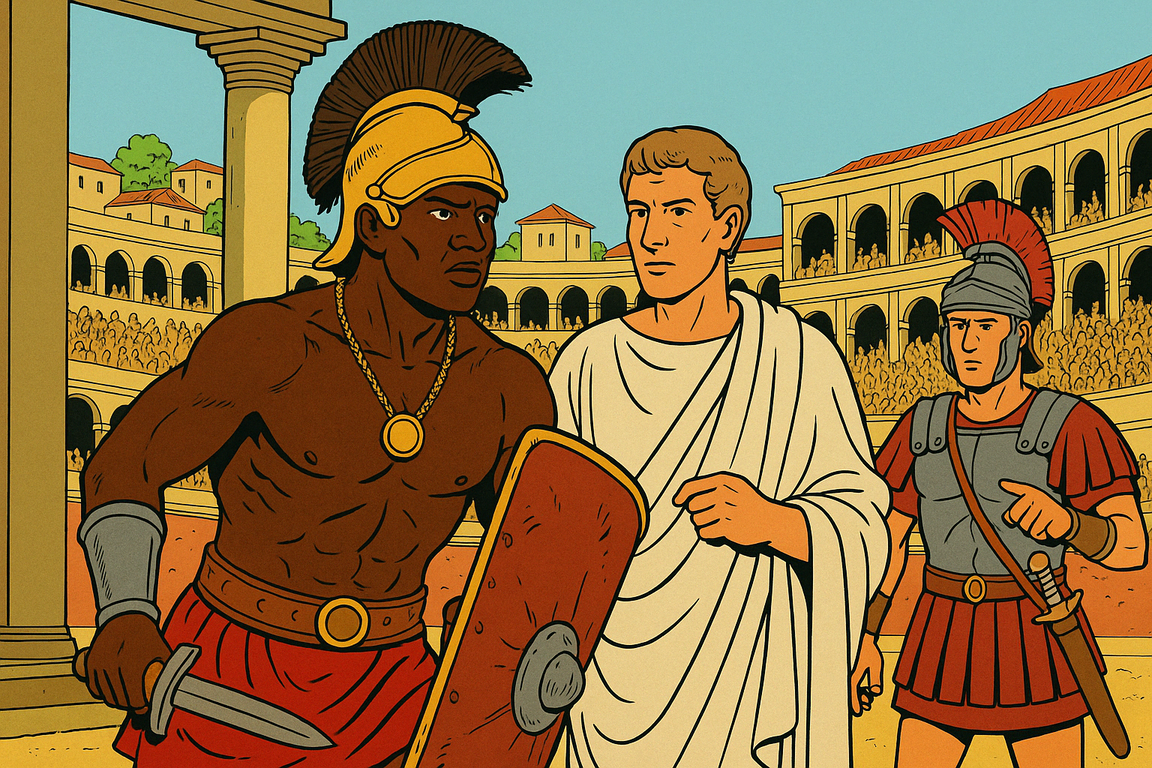
In contemporary collective imagination, Africans in ancient Rome are most often relegated to frozen images: silent slaves in patrician villas, exotic curiosities in Pompeian frescoes, anonymous silhouettes in the arenas. But this perspective reflects not Antiquity itself, but the lenses through which modern Europe has reinterpreted it.
The idea of an ethnically “white” Rome is a fiction. The Roman Empire was a world of migrations, mixtures, conquests—and therefore, of hybridization. Rome was not an isolated village on the banks of the Tiber. It was an imperial capital, a crossroads of influence where Syrians, Iberians, Celts, Egyptians, Nubians, Greeks, Jews, and of course, sub-Saharan Africans met.
These Africans—often referred to as Aethiopes in Latin texts—were visible in the city: in markets, in entertainment, in the military, in households. Far from being absent, they were integrated—sometimes marginalized, yes—but always present.
The meticulous work of historian Frank M. Snowden, supported by abundant iconography and precise literary sources, highlighted a reality often erased: skin color was not, in Rome, a criterion of status or racial essentialism.
It was thus possible (and documented) to be Black and free, white and enslaved, or Black and a Roman citizen.
Roman slavery was based on military, economic, and legal factors. One became a slave by losing a war, being born to enslaved parents, or being sold. This applied equally to Gauls, Numidians, Dacians, and Ethiopians.
And, importantly, manumission was common. The libertus institution allowed a former slave to gain freedom—and often Roman citizenship. Some freed individuals became wealthy patrons, architects, merchants, even priests of official cults.
In the realm of entertainment, Africans occupied a paradoxical position. They were both exhibited for their difference—in arenas, theaters, games—and valued for their talents.
- Black gladiators: depicted in mosaics, sometimes adored like stars, selected for their strength and distinctiveness. Iconography even shows them in victorious poses.
- Singers, musicians, actors: Africa was also linked to vocal and stage talent. Exoticism fed public fascination without necessarily erasing artistic respect.
- Acrobats and dancers: often from sub-Saharan Africa, they performed at banquets and in circuses, sometimes in itinerant troupes across the Empire.
In the military, African presence was even more significant. Nubians, Moors, and Libyans fought for Rome—sometimes as auxiliaries, sometimes within regular legions. The case of Lucius Quietus, a Moorish general under Emperor Trajan, is emblematic. He became governor of Judea, a respected military leader—proof that skin color did not bar ascent in the imperial apparatus, so long as loyalty to Rome was demonstrated.
And what of Septimius Severus, Roman emperor born in Leptis Magna, present-day Libya? His reign marked the height of imperial cosmopolitanism—where geographic origin, if not skin color, did not prevent access to supreme power.
Roman art abounds with depictions of Black individuals. They appear in mosaics, cameos, bas-reliefs, bronze statuettes. These figures are often clearly defined: Negroid features, dark skin, tightly curled hair, specific body morphology.
Yet this visibility is ambivalent. It can be tribute or caricature, realism or exoticization. Sometimes honored, sometimes mocked, the figure of the Black person was included—but not equally—nor as part of a systematic racial order.
Rome viewed the world with a sense of superiority, but not along the lines of modern racism. It dominated—but did not biologically “naturalize” inferiority.
The real question is that of silence. Why, in today’s popular culture, have these figures been erased?
Because modern constructions of Antiquity—especially in the 19th century—whitened Rome. A racial genealogy of civilization had to be manufactured, one in which Europe appeared as the natural heir to ancient grandeur. In this vision, Black people could only exist as slaves. Any other role became heresy.
To rehabilitate the African presence in Rome is therefore to restore a historical truth—but also to dismantle a racial myth. It is to remind the world that Black people did not arrive in history with the transatlantic slave trade. They were already there—and sometimes at the heart of power.
Kush versus Rome: The meroitic example
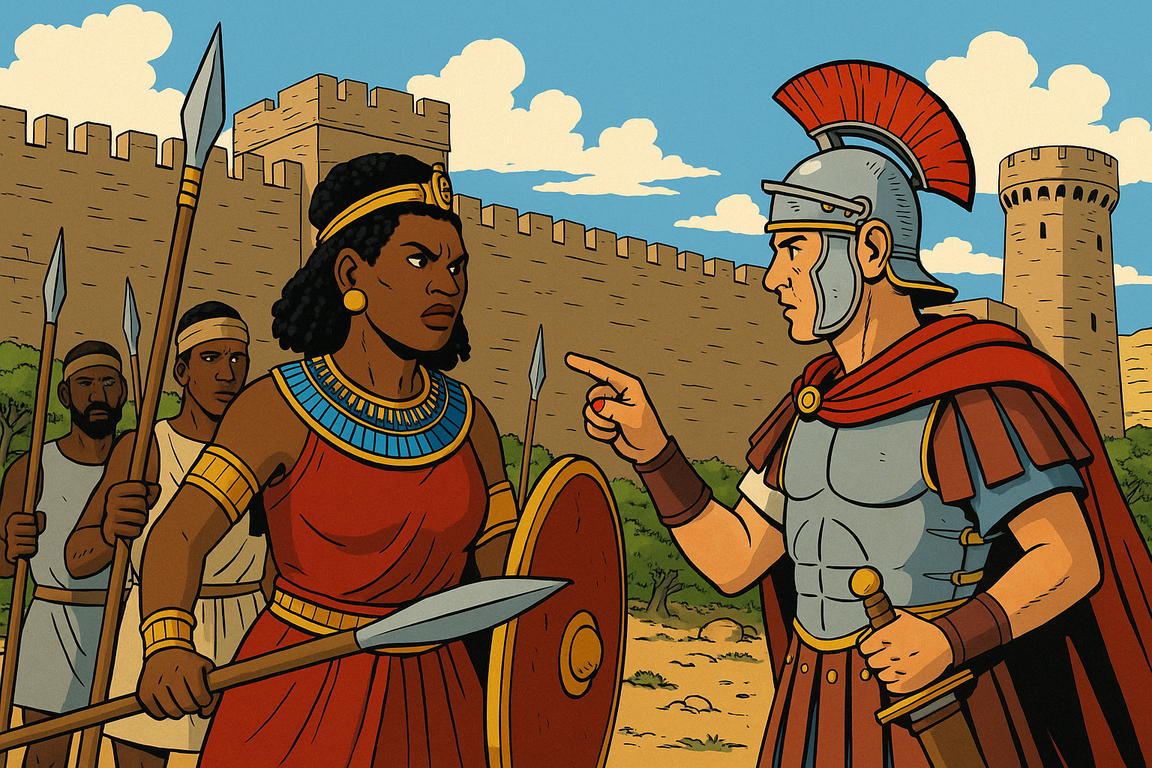
In the most classic history textbooks, Rome’s expansion appears inexorable and triumphant, crushing all in its path. From Britain to Mesopotamia, the empire imposed itself—conquering territories, peoples, and gods. Yet at the southern edge of Roman Egypt, an African power led by a woman said no—and Rome retreated.
That power was the Kingdom of Kush, specifically in its Meroitic period. Located in what is now Sudan, south of the First Cataract of the Nile, Kush inherited the legacy of Pharaonic Egypt but with its own distinctive culture: Meroitic script, unique art, pyramid architecture, and a highly centralized political structure.
When Egypt fell under Roman control after the defeat of Cleopatra and Mark Antony at Actium in 31 BCE, Rome inherited a strategic southern neighbor it knew little about: Kush. By 25 BCE, tensions escalated. Taking advantage of the Roman army’s redeployment, Kushite forces launched a lightning raid on Syene (modern-day Aswan), sacked the region’s cities, captured prisoners—and even beheaded statues of Emperor Augustus.
This was more than a military act. It was a potent political statement—a symbolic desecration. By attacking the image of the emperor, the Kushites affirmed their sovereignty and rejection of Roman domination.
Leading this offensive was Amanirenas, kandake of the kingdom—meaning queen mother and military regent. History tells us little about her, except that she was blind in one eye (likely from battle) and that she personally commanded troops. Her name, inscribed on Meroitic stelae, resonates today as one of the rare women in ancient history to have militarily resisted Rome without surrendering.
This is no late feminist anecdote—it is a historical fact rich with meaning. While Rome confined women to the private sphere, the Meroitic kingdom placed at its helm a warrior, a head of state, a negotiator. Amanirenas is the Nile Valley’s southern counterpart to Boudicca in Britain or Cleopatra in Egypt—except she wins.
Rome responded with force. General Caius Petronius led a punitive expedition, destroying Napata, Kush’s former religious capital. But he failed to crush Kushite resistance. The conflict bogged down; the cost became disproportionate. Emperor Augustus, pragmatic, accepted negotiation.
The treaty signed around 21 BCE, as reported by the Greek geographer Strabo, is simply unprecedented in Roman history:
- Rome abandoned its southern expansion plans.
- Imperial troops withdrew to Syene.
- No tribute was imposed on Kush.
- The border was formally recognized, legitimizing the kingdom’s integrity.
This treaty was no gift—it was a diplomatic Kushite victory, won not through appeasement, but through war and negotiation. Unlike other conquered peoples, the Meroites earned Rome’s respect through strength and diplomacy.
Why is this episode so little known? Why isn’t Amanirenas taught alongside Hannibal or Vercingetorix?
Perhaps because she disrupts the narrative. Because she undermines the myth of a white, virile, and victorious Antiquity. Because she reveals an Africa that was sovereign, organized, and capable of forcing the most powerful empire in history to back down.
In classical representations of Rome, there is no space for victorious Black resistance. No frescoes for the kandakes. No films. No pantheon.
And yet, the records exist. Strabo wrote it. The temples of Meroë display it. The stelae confirm it. The past does not lie—you only have to read it.
Fragmented memories, histories to rebuild
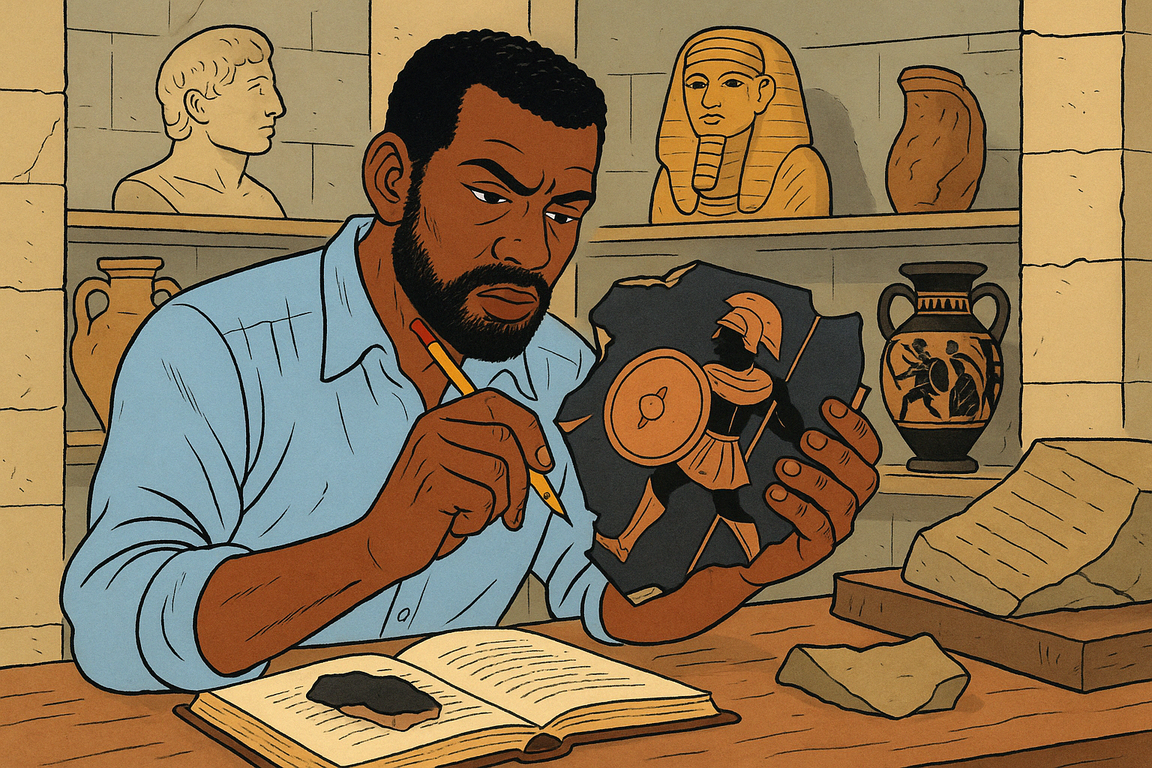
There exists a strange amnesia at the heart of the Western narrative of Antiquity—a carefully cultivated blindness. In school textbooks, classical art museums, and historical fiction, Africa rarely appears. And when it does, it is often as a silent margin, a backdrop of exoticism.
Yet ancient Africa was neither mute nor marginal. It was a participant, a counterpart, and at times, an inspiration to the Greco-Roman world.
So why was it forgotten?
For a long time, the Greeks and Romans acknowledged human diversity without necessarily ranking it by skin color. Ethiopians, Egyptians, and Numidians were peoples among others—sometimes enemies, sometimes allies—but always seen in their complexity.
It was only with the rise of European colonialism, between the 15th and 19th centuries, that the idea of “race” emerged as a dominant framework. This framework, retroactively applied to Antiquity, whitened Rome and Greece while darkening Africa with ignorance and barbarism.
In this revisionism, Africans of Antiquity were either erased or reclassified as strange exceptions—never representative.
This process was not merely passive forgetfulness. It was part of a broader strategy: the erasure of Black power from the story of civilization. By excluding Africa from Greco-Roman genealogies, modern Europe justified slavery, colonization, and guardianship over African peoples.
Restoring Africa’s place in ancient history is therefore not just a matter of scholarship—it is an act of reparation.
It is to say: You were there. You were part of the world. You contributed to classical culture—not on the margins, but at its core.
Since the 1970s, African, Afro-descendant, and allied critical scholars have begun reconstructing this fragmented memory. Historians like Cheikh Anta Diop, Frank Snowden, Runoko Rashidi, and Mario Beatty have illuminated the Black presence in Antiquity through rigorous methods, cross-referenced sources, and a demand for historical truth.
Their work has brought figures like Memnon, Amanirenas, the Black soldiers of the Roman army, and Egyptian philosophers in Alexandrian schools back to life. And through them, an entire part of the Greco-Roman world has regained its original colors—diverse, vibrant, and real.
But this work remains fragile. Because history is not written only with pens—it is also written with institutions. And until these narratives are integrated into curricula, museums, and dominant storytelling, they will remain sidelined.
For a radical rereading of antiquity
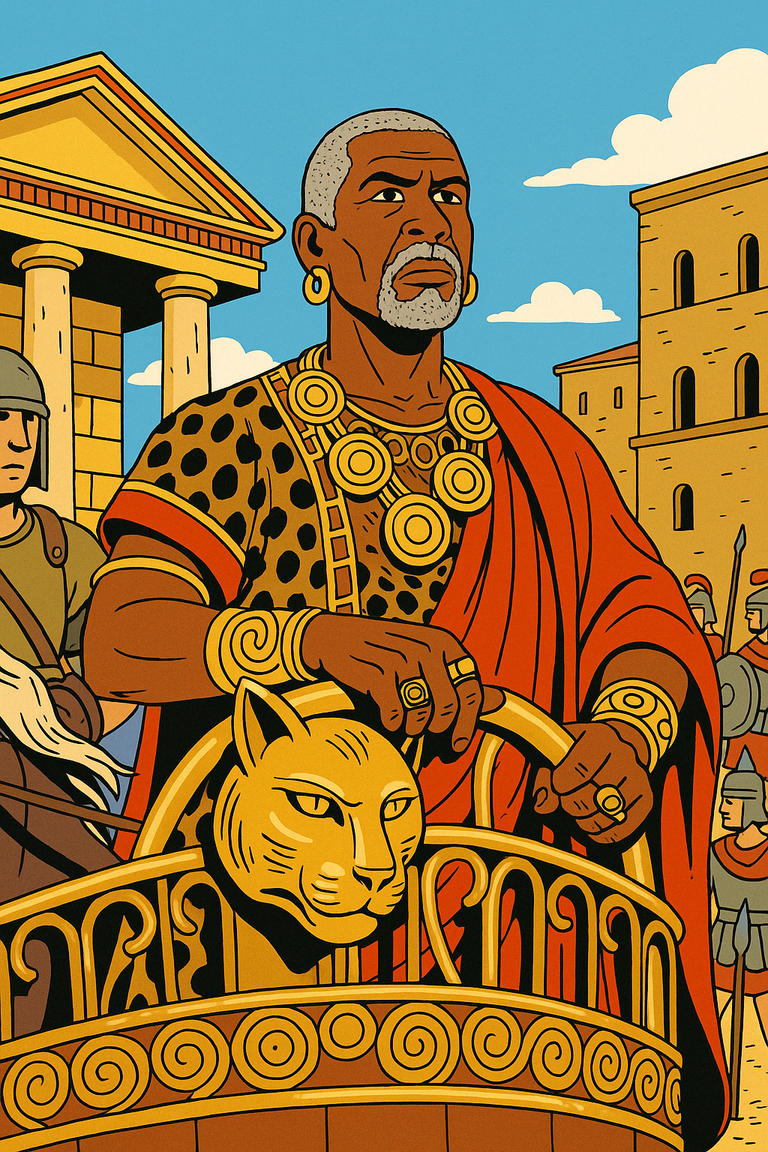
To rewrite history is not to distort the truth. It is to correct what others have deformed.
The idea of a white, rigid Antiquity—foundational to a homogeneous West—is not the legacy of Homer or Plutarch. It was not born in the temples of the Parthenon or beneath the arches of the Pantheon. It was manufactured, meticulously, with racial ink and imperial scalpels, in the libraries of 19th-century Europe.
This bleached and sanitized version of Antiquity is a political invention. It served to justify colonization, legitimize slavery, and build a historical narrative in which Europe appears as the sole heir to civilization—and Africa as its organic opposite.
But real Antiquity, the one revealed by sources, excavations, and silenced voices, is plural. It is Black, mixed, mercantile, nomadic. It is woven from encounters, conflicts, exchanges, and fusions.
The backlash against Denzel Washington’s casting in Gladiator II says more about us than about history itself. That presence shocks not because it is historically implausible, but because it breaks a myth—the myth of an ethnically pure Rome, white-skinned, Greek-blooded, and European in soul.
And yet: Black people lived in Rome. They served as soldiers, worked as merchants, danced as artists, and fought as gladiators. Some were slaves—yes—but others were free, freedmen, even powerful. The Roman Empire, in all its vast diversity, included without structuring society according to biological race.
Denzel in the arena is not a modern reinterpretation. It is a restitution of a suppressed reality. It is putting a Black body back where it had been erased by two centuries of Eurocentric visual culture.
Reintegrating Africa into the Greco-Roman narrative is not an identity claim—it is a pedagogical necessity.
As long as children of African descent see only servile or exotic figures in Antiquity, they will be excluded—by omission—from the heart of what is called “classical” culture. As long as Black people are only visible in modern slavery, their history will seem to begin with their subjugation.
And this has real consequences—for self-esteem, for collective imagination, for the sense of legitimacy to study literature, philosophy, or politics.
A radical rereading of Antiquity—one that includes Memnon, Amanirenas, Septimius Severus, and the thinkers of Alexandria—is an inclusive rereading. It does not deny Europe. It enriches it, by showing that universality is not the monopoly of the West, but the fruit of ancient circulations.
To give Africa its place in the classical story is not just to acknowledge the past. It is to rearm the future—symbolically.
It is to remind us that Black history does not begin in the holds of slave ships, but in the temples of Kemet, the walls of Meroë, the libraries of Carthage. It is to recall that Africans have philosophized, governed, built, invented—long before they were colonized.
It is also to question what we call “the universal.” Because if the universal reflects only the white faces of European memory, then it is merely a particular masquerading as the center.
A true universal can only be born when every people can see themselves in it—can inscribe their names, their dead, their gods, their heroes.
What we call Rome or ancient Greece were never closed-off civilizations. They were crossroads, crucibles, sites of synthesis.
What we call Africa—long pushed out of the classical narrative—was in fact present, active, familiar, far more than official history has admitted.
To rewrite Antiquity in light of this truth is to unravel colonial fictions, to give voice to the silences, and to resurrect invisible presences.
It is to make History—not a wall—but a mirror.
Notes and general references
- Herodotus, Histories, Book II, trans. A. Barguet, GF Flammarion, 1995.
- Martin Bernal, Black Athena: The Afroasiatic Roots of Classical Civilization, Rutgers University Press, vol. I–III, 1987–2006.
- Cheikh Anta Diop, The African Origin of Civilization: Myth or Reality / Nations nègres et culture, Présence Africaine, 1954.
- Quintus of Smyrna, Posthomerica, trans. P. Waltz, CUF, 1940.
- Agatharchides of Cnidus, On the Erythraean Sea, fragments in Diodorus of Sicily, Book III.
- Frank M. Snowden Jr., Blacks in Antiquity: Ethiopians in the Greco-Roman Experience, Harvard University Press, 1970.
- Runoko Rashidi, African Star over Asia: The Black Presence in the East, Books of Africa, 2012.
- Frank M. Snowden Jr., Before Color Prejudice: The Ancient View of Blacks, Harvard University Press, 1983.
- Shelley Haley, “Be Not Afraid of the Dark: Critical Race Theory and Classical Studies,” Classical World, Vol. 106, No. 2, 2013.
- Duane W. Roller, The World of Juba II and Kleopatra Selene, Routledge, 2003.
- A. D. H. Bivar, “The Africans in Roman Britain,” Antiquity, 43(171), 1969.
- Strabo, Geography, Book XVII, trans. F. Lasserre, CUF, 1975.
- Derek A. Welsby, The Kingdom of Kush: The Napatan and Meroitic Empires, Markus Wiener Publishers, 1996.
- P. L. Shinnie, Ancient Nubia, Methuen, 1978.
- D. T. Niane (ed.), General History of Africa, UNESCO, Vol. II, 1984.
- Michel-Rolph Trouillot, Silencing the Past: Power and the Production of History, Beacon Press, 1995.
- Mary Lefkowitz & Guy MacLean Rogers (eds.), Black Athena Revisited, University of North Carolina Press, 1996.
- Mario Beatty, “Africa and the Classical World,” The Journal of Pan African Studies, Vol. 7, No. 1, 2014.
- Paulin Hountondji, Sur la “philosophie africaine”, Maspero, 1976.
- Fondation pour la Mémoire de l’Esclavage, Africa and Greece: The Invisible Legacy, Thematic Note, 2023.
- Mary Beard, SPQR: A History of Ancient Rome, Liveright, 2015.
- Dan-el Padilla Peralta, “Undocumented,” The New York Times Magazine, January 2016.
- Saidiya Hartman, Lose Your Mother: A Journey Along the Atlantic Slave Route, Farrar, Straus and Giroux, 2007.
- Ahmed Baba Institute (Timbuktu), manuscript archives on precolonial Africa.
Table of Contents
- The Black Faces of Antiquity
- Africa at the Origins of the Classical World
- Memnon, the Black Hero of the Trojan War
- Africans in Rome
- Kush versus Rome: The Meroitic Example
- Fragmented Memories, Histories to Rebuild
- For a Radical Rereading of Antiquity
- Notes and General References
